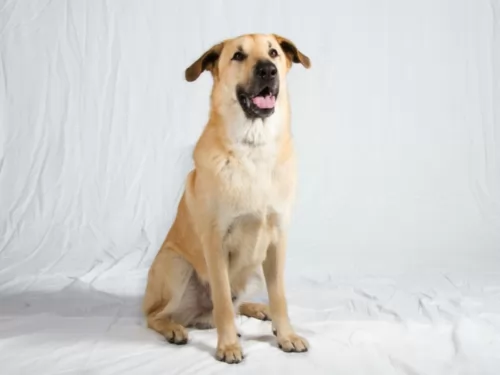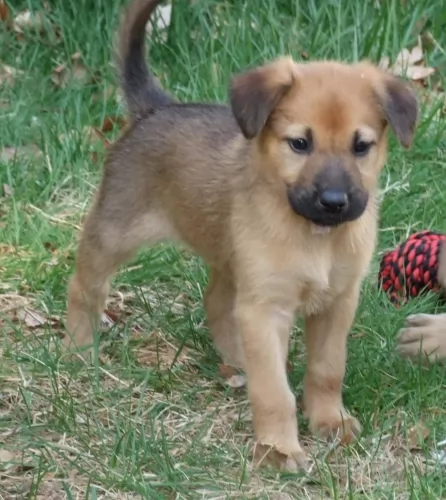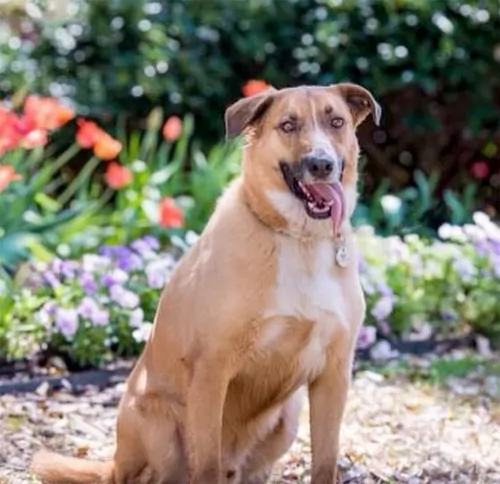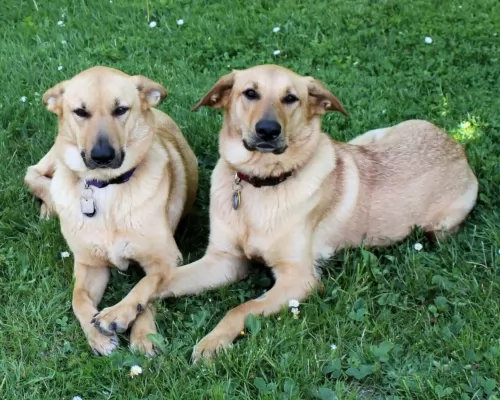 Petzlover
PetzloverChinook is originated from United States but Guejae Gae is originated from South Korea. Chinook may grow 11 cm / 5 inches higher than Guejae Gae. Chinook may weigh 14 kg / 31 pounds more than Guejae Gae. Both Chinook and Guejae Gae has almost same life span. Both Chinook and Guejae Gae has almost same litter size. Chinook requires High Maintenance. But Guejae Gae requires Moderate Maintenance
 In the early 20th century, in the small town of Wonalancet, New Hampshire a new breed of dog called the Chinook was born. Developed by Arthur Treadwell Walden, the breed is named after the first male ancestor who was named Chinook. The breed is a rare sled dog and the official dog of the state of New Hampshire. The Chinook was born of a cross between a large Mastiff-like street dog and huskies that were part of the Peary North Pole expedition.
In the early 20th century, in the small town of Wonalancet, New Hampshire a new breed of dog called the Chinook was born. Developed by Arthur Treadwell Walden, the breed is named after the first male ancestor who was named Chinook. The breed is a rare sled dog and the official dog of the state of New Hampshire. The Chinook was born of a cross between a large Mastiff-like street dog and huskies that were part of the Peary North Pole expedition.
Walden was an experienced slender and looking for a dog that was stronger, faster and had more stamina than his current sled dogs. Walden had years of experience including being the trainer and lead on Byrd’s 1929 Antarctic expedition and plenty of Yukon experience. Once he had the male Chinook he bred him with German Shepherds, Belgian Sheepdogs and Canadian Eskimo Dogs at the very least. He then bred those puppies back to Chinook until he had the type and traits he wanted. Following Walden, Julia Lombard and then Perry Greene took over mastery of the breed. From the 1940’s until he died in 1963, Greene was the only person who was breeding Chinooks. So, there were few left after his death. The breed neared extinction by 1981 with only 11 Chinooks available to breed. These dogs were divided between three breeders who saved the breed from becoming extinct.
In 1991, the United Kingdom recognized the Chinook and they were also registered with the UKC. At that time there were about 800 dogs in the breed. To increase the breed, there was a cross-breeding program that took Chinooks and bred them back to the breeds they considered to be apart of the original Chinook lineage. These 4th generation dogs might meet the standards of the Chinook Owners Associations Cross Breeding Program and be accepted as purebred.
In 2001 the Chinook was entered into the AKC Foundation Stock Service and added to the Miscellaneous class of the AKC in 2010. In January of 20113, the Chinook was finally granted full recognition and breed status within the AKC in the working group. He is a large working dog, rugged, patience, loyal and intelligent. He is one of the rarest breeds in the AKC.
Known also as Gaulchae Gae, the Guejae Gae hails from Korea, and falls in the Spitz dog category. The dog is related to the Korean Jindo dog but is slightly larger.
With his sharp canine teeth, the Guejae has been used for hunting and herding, having enough stamina to not easily give up on its prey. The dog isn’t AKC recognized.
 The Chinook is a muscular dog, making him a perfect fit to be a sled dog or a hauler of any type. He has a deep chest and powerful muzzle with enduring teeth. The ears can be pricked up or bent and wind-blown. The nostrils of the Chinook are solid black and wide, while the lips are black, the eyes look like almonds and are dark with intelligence in their glance. The feet are firm and oval, the pads cushioned and with dark pigmentation. The tail should not be docked.
The Chinook is a muscular dog, making him a perfect fit to be a sled dog or a hauler of any type. He has a deep chest and powerful muzzle with enduring teeth. The ears can be pricked up or bent and wind-blown. The nostrils of the Chinook are solid black and wide, while the lips are black, the eyes look like almonds and are dark with intelligence in their glance. The feet are firm and oval, the pads cushioned and with dark pigmentation. The tail should not be docked.
The breed has a double coat and hair of medium length The undercoat is soft and thick while the outercoat is close to the body and coarse. The Chinook is usually a tawny, reddish color.
This is a medium sized dog, standing at roughly 40cm to 58cm and weighing about 16 to 27kg, and because he falls into the Spitz dog category, you’ll find them with the characteristic pointed ears and thick fur.
He can be in a number of colors such as fawn, brown, white, grey or black. The tail curls up over the back too and the dog has a resemblance to the wolf. You can see he is intelligent as has he has bright, alert eyes.
These dogs aren't aggressive and they are known to be gentle dogs who are devoted and loyal to their owners.
He is an active, intelligent, social dog who wants ongoing interaction with his human family. He should never be left alone in the back yard day after day as he becomes lonely and bored. This is terrible to do for any dog breed, but the Guejae Gae won't thrive in a family who doesn't make him 100% part of the family.
He should be allowed indoors with his owner as he is a highly social dog who loves being around his human family, forming deep bonds with them.
His superb intelligence allows him to learn new commands and tricks easily, and this is why he responds well to training and socialization. He makes a great pet for active owners and gets on well with children in the home as well as pets. Because he is somewhat reserved around strangers, he makes a good watchdog too.
 This is a playful, affectionate and loyal breed. They have a special love for kids and always want to learn and please you. They are intelligent and very trainable. The Chinook is good with other dogs and as a sled dog they love to work in packs. They can be reserved but they are never aggressive or shy.
This is a playful, affectionate and loyal breed. They have a special love for kids and always want to learn and please you. They are intelligent and very trainable. The Chinook is good with other dogs and as a sled dog they love to work in packs. They can be reserved but they are never aggressive or shy.
Intelligent, playful, faithful and loving, your Guejae Gae is going to make you a splendid pet – good with other pets in the home as well as with children.
They are good natured pets and easy to train too, so that when he has been trained and socialized, he becomes an even more amicable pet.
Just remember though that these dogs have been used as working dogs and to ensure your Guejae Gae makes you a splendid pet, you want to ensure he has enough exercise to keep him happy and healthy.
 For the most part, the Chinook is a healthy dog. There are however some issues they do have to contend with including:
For the most part, the Chinook is a healthy dog. There are however some issues they do have to contend with including:
Sometimes know as Chinook seizures this is really a movement disorder and perhaps not a true epilepsy.
This dermatitis may be hereditary. It causes itchy skin and is actual an immune system issue.
Chinook are known for a variety of gastrointestinal disorders manifested by diarrhea and vomiting.
There are always common dog illnesses to watch out for however, and in this spitz-type dog, hypothyroidism is one.
Hypothyroidism in dogs is usually brought on by inflammation of the thyroid gland. Hypothyroidism occurs more often in medium to large dogs as opposed to smaller breeds. The most common signs of low thyroid function in your pet will be loss of fur and excess shedding, weight gain and an inability to tolerate the cold.
Hypothyroid dogs often battle with ear infections as well as skin infections. There are a number of blood tests to confirm a suspected diagnosis of hypothyroidism in your dog.
 Don’t overfeed your dog. Based on how hard he is working for you feed twice a day. Dividing 3 to 5 cups into two meals.
Don’t overfeed your dog. Based on how hard he is working for you feed twice a day. Dividing 3 to 5 cups into two meals.
Although the Chinook is still active in recreational sledding, he is mostly a family pet these days. Given this the Chinook need a good deal of exercise and competition. They are great at search and rescue, dog packing, agility, obedience, herding, carting and skijoring. They need some form of solid exercise for 30 to 60 minutes every day.
He sheds quite a bit and more so in hot weather so he will need to be thoroughly brushed twice a week.
The Guejae Gae is an active dog breed that needs plenty of place to roam freely, and therefore he is a dog breed that will suit life in the country far better than life in the city.
You will need a decent sized yard for him and you should also be prepared to take him on walks and play ball games with him. He is such a social dog and playing with him is something that will strengthen your bond.
As a Spitz type dog, the Guejae Gae has always enjoyed a carnivorous diet. Cheap, poor quality commercially manufactured dog food won’t cut it for these dogs. Home cooked meals with natural ingredients such as chicken, brown rice and vegetables is a good choice as well as adding in some raw meat from time to time.
Always remember when feeding your Guejae Gae that how much your dog eats will depend on his size, age and activity levels. A highly active dog like the Guejae Gae needs wholesome food as well as a constant supply of fresh, cool water.